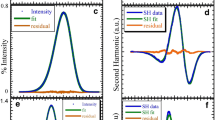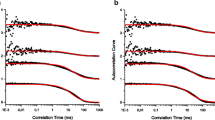Abstract
The fluorescence spectra of retinol obtained in bilayer structures of two different systems with dodecyl tetraethylenglycol ether are shown. A correlation between the fluorescence intensity of retinol and the different topologies of bilayers has been found. We have tested this correlation with the C12E4/benzyl alcohol/water system, and we have also applied this idea to the study of the lamellar phases of the C12E4/PEG/water system. The highest fluorescence intensity of retinol corresponds to unilamellar vesicles, while the lowest is observed for multilamellar vesicles. The kinetic study of the degradation of vitamin A in these media is also related to the different microstructures of the bilayers.







Similar content being viewed by others
References
Evans F, Wennerström H (1999) The colloidal domain. Where physics, chemistry, biology, and technology meet. Wiley-VCH, New York
Makai M, Csányi E, Németh Z et al (2003) Structure and drug release of lamellar liquid crystals containing glycerol. Int J Pharm 256:95–107
Nii T, Ishii F (2005) Encapsulation efficiency of water-soluble and insoluble drugs in liposomes prepared by the microencapsulation vesicle method. Int J Pharm 298:198–205
Garcia-Fuentes M, Alonso MJ, Torres D (2005) Design and characterization of a new drug nanocarrier made from solid–liquid lipd mixtures. J Colloid Interface Sci 285:590–598
Hoffmann H (1994) Viscoelastic surfactan solutions. In: Herb CA, Prud’homme RK (eds) Structure and flow in surfactant solutions. ACS Symposium Series 578, pp 2–31
Caboi F, Monduzzi M (1998) On microstructural transitions of lamellar phase forming surfactants. Prog Colloid & Polym Sci 108:153–160
Gradzielski M (2003) Vesicles and vesicle gels—structure and dynamics of formation. J Phys, Condens Matter 15:R655–R697
Schomäcker R, Strey R (1994) Effect of ionic surfactants on nonionic bilayers: bending elasticity of weakly charged membranes. J Phys Chem 98:3908–3912
Bergenholtz J, Wagner NJ (1996) Formation of AOT/brine multilamellar vesicles. Langmuir 12:3122–3126
Auguste F, Douliez JP, Bellocq AM et al (1997) H-NMR and freeze fracture electron microscopy. Langmuir 13:666–672
Regev O, Khan A (1994) Vesicle–lamellar transition events in DDAB–water solution. Prog Colloid & Polym Sci 97:298–301
Gomati R, Appell J, Bassereau P et al (1987) Influence of the nature of the counterion and of hexanol on the phase behavior of the dilute ternary systems: cetylpyridinium bromide or chloride–hexanol–brine. J Phys Chem 91:6203–6210
Strey R, Schomäcker R, Roux D et al (1990) Dilute lamellar and L3 phases in the binary water–C12E5 system. J Chem Soc, Faraday Trans 86(12):2253
Platz G, Thunig C, Hoffmann H (1992) Phase behavior and light scattering of the system dodecyldimethylaminoxide, n-hexanol and water in the very dilute region. Ber Bunsenges Phys Chem 96:667–677
Jönsson B, Wennerström H (1987) Phase equilibria in a three-component water–soap–alcohol system. A thermodynamic model. J Phys Chem 91:338–352
Caria A, Regev O, Khan A (1998) Surfactant–polymer interactions: phase diagram and fusion of vesicle in the didodecyldimethylammonium bromide–poly(ethylene oxide)–water system. J Colloid Interface Sci 200:19–30
Takeoka S, Mori K, Ohkawa H et al (2000) Synthesis and assembly of poly(ethylene glycol)-lipids with mono-, di-, and tetracyl chains and a poly(ethylene glycol) chain of various molecular weights. J Am Chem Soc 122:7927–7935
Montalvo G, Rodenas E, Valiente M (1998) Phase and rheological behavior of the dodecyl tetraethylene glycol/benzyl alcohol/water system at low surfactant and alcohol concentrations. J Colloid Interface Sci 202:232–237
Montalvo G, Valiente M, Mortensen K et al (2001) Structural changes induced in the surfactant system C12E4/benzyl alcohol/water by the admixture of the cationic surfactant cetylpyridinium chloride. J Colloid Interface Sci 238:215–258
Montalvo G, Rodenas E, Valiente M (2000) Effects of cetylpyridinium chloride on phase and rheological behavior of the diluted C12E4/benzyl alcohol/water system. J Colloid Interface Sci 227:171–175
Radlihska EZ, Zemb TN, Dalbiez JP et al (1993) Lamellar to vesicle transitions of highly charged bilayers. Langmuir 9:2844–2850
Clegg SM, Williams PA, Warren P et al (1994) Phase behavior of polymers with concentrated dispersions of surfactants. Langmuir 10:3390–3394
Piculell L, Bergfeldt K, Gerdes S (1996) Segregation in aqueous mixtures of nonionic polymers and surfactant micelles. Effects of micelle size and surfactant headgroup–polymer interactions. J Phys Chem 100:3675–3679
Bernheim-Groswasser A, Wachtel E, Talmon Y (2000) Micellar growth, network formation, and criticality in aqueous solutions of the nonionic surfactant C12E5. Langmuir 16:4131–4140
Arnhold T, Nau H, Ruehl R (2000) Vitamin A. In: Song WO, Beecher GR, Eitenmiler RR (eds) Modern analytical methodologies in fat- and water-soluble vitamins, chapter 1. Wiley, New York
Farn RJ (ed) (2006) Chemistry and technology of surfactants. Blackwell, Ames (Iowa)
Myers D (2006) Surfactant science and technology. Wiley, Hoboken
Muñoz-Botella S, Martín MA, del Castillo B et al (2002) Differentiating geometrical isomers of retinoids and controlling their photo-isomerization by complexation with cyclodextrins. Anal Chim Acta 468:161–170
Sapino S, Carlotti ME, Cavalli R et al (2007) Effect of Akyl-γ-cyclodextrins on the stability of retinol. J Incl Phenom Macrocycl Chem 57:451–455
Singh AK, Das J (1998) Liposome encapsulated vitamin A compounds exhibit greater stability and diminished toxicity. Biophys Chem 73:155–162
Arsic I, Vidovic A (1999) Influence of liposomes on the stability of vitamin A incorporated in polyacrylate hydrogel. Int J Cosm Sci 21:219–225
Lee MH, Oh SG, Moon SK et al (2001) Preparation of silica particles encapsulating retinol using O/W/O multiple emulsions. J Colloid Interface Sci 240:83–89
Hwang YJ, Oh C, Oh SG (2005) Controlled release of retinol from silica particles prepared in O/W/O emulsion: the effects of surfactants and polymers. J Control Release 106:339–349
Jee JP, Lim SJ, Park JS et al (2006) Stabilization of all-trans retinol by loading lipophilic antioxidants in solid lipid nanoparticles. Eur J Pharm Biopharm 63:134–139
Han SH, Lee JS, Kim Y et al (2007) Quantitative characterization of degradation behaviors of antioxidants stabilized in lipid particles. Talanta 71:2129–2133
Lin JM, Yamada M (2003) Microheterogeneous systems of micelles and microemulsions as reaction media in chemiluminescent analysis. Trends Anal Chem 22:99–107
Ramos-Lledó P, Vera S, San Andrés MP (2001) Determination of vitamins A and E in milk samples by fluorescence in micellar media. Fresenius J Anal Chem 369:91–95
León-Ruiz V, Vera S, San Andrés MP (2005) Validation of a screening method for the simultaneous identification of fat-soluble and water-soluble vitamins (A, E, B1, B2 and B6) in an aqueous micellar medium of hexadecyltrimethylammonium chloride. Anal Bioanal Chem 381:568–1575
Torre M, Sánchez-Hernández M, Vera S et al (2008) Improvement in retinol analysis by fluorescence and Solid Phase Extraction (SPE) in micellar medium. J Fluoresc 18:487–449
Yoshida K, Sekine T, Matsuzaki F et al (1999) Stability of Vitamin A in Oil-in-Water-in-Oil-Type Multiple Emulsions. J Am Oil Chem Soc 76(2):1–6
Acknowledgements
The authors thank the Spanish Ministry of Education and Science for its financial support for the research project CTQ2007-65421/BQU.
Author information
Authors and Affiliations
Corresponding author
Rights and permissions
About this article
Cite this article
Torre, M., San Andrés, M.P., Vera, S. et al. Retinol fluorescence: a simple method to differentiate different bilayer morphologies. Colloid Polym Sci 287, 951–959 (2009). https://doi.org/10.1007/s00396-009-2051-y
Received:
Revised:
Accepted:
Published:
Issue Date:
DOI: https://doi.org/10.1007/s00396-009-2051-y




